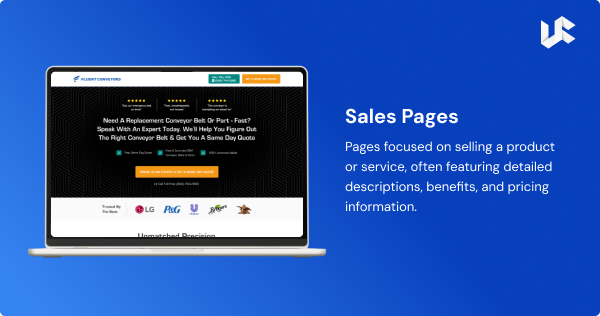In the ever-evolving digital marketing landscape, understanding the difference between a pillar page vs landing page is crucial for creating a robust online presence. Both play unique roles in driving traffic, generating leads, and converting visitors into customers.
This article delves deep into the definitions, purposes, structures, and best practices of pillar and landing pages to help you leverage these tools effectively in your marketing strategy.
1. Understanding Pillar Pages

What is a Pillar Page?
A pillar page is a comprehensive, long-form content piece that serves as the central hub for a broad main topic. It provides exhaustive information on the subject and includes helpful internal links to more detailed pieces of content on specific subtopics.
This structure not only improves user experience but also enhances SEO rankings by creating a robust content cluster around the core topic.
Purpose of a Pillar Page
The primary goal of a pillar page is to provide a thorough and authoritative resource on a given topic. By doing so, it aims to:
Enhance SEO:
Pillar pages are designed to rank highly on search engines for broad keywords. By linking to and from cluster content, they help improve your website’s overall SEO.
Improve User Experience:
They offer users a one-stop resource for comprehensive information, reducing the need to navigate multiple pages.
Establish Authority:
By providing in-depth, valuable content, pillar pages position your brand as an authority in your niche.
Structure of a Pillar Page

A pillar page typically includes:
- Introduction: A brief overview of the topic.
- Main Sections: Detailed explanations of various aspects of the topic, often divided into subheadings for clarity.
- Links to Cluster Content: Hyperlinks to related articles or blog posts that delve deeper into specific subtopics.
- Visuals: Images, videos, infographics, and other media to enhance engagement and understanding.
- Call to Action (CTA): Encourages users to take a desired action, such as subscribing to a newsletter or downloading a resource.
Three Types of Pillar Pages
- The 10X Content Pillar Page: This is a long-form, ultimate guide intended to be 10 times better than the top-ranking article for the targeted keyword. It offers a comprehensive overview of a topic, with sections that delve deeply into subtopics, often navigable via a table of contents.

- The Hub Pillar Page: This page acts as a resource library, organizing content around a specific topic in one place. It’s typically light on text and links to more in-depth internal and external content, improving the site’s structure. Example: Qualtrics’s Employee Experience page.

- The Hybrid Pillar Page:
Combining elements of the 10X and hub pillar pages, this type offers long-form content with a thorough topic overview while linking to other resources within the content hub.
2. Understanding Landing Pages

What is a Landing Page?
A landing page is a standalone web page created specifically for a marketing or advertising campaign. It is where a visitor “lands” after clicking on a link in an email, advertisement, social media post, or other digital marketing channels.
Unlike other pages on your website, a landing page is designed with a single, focused objective: to drive conversions.
Purpose of a Landing Page
The primary goal of a landing page is to convert visitors into leads or customers. This is achieved by:
Eliminating Distractions:
Landing pages have minimal navigation options to keep visitors focused on the call to action.
Targeting Specific Audiences:
They are tailored to meet the needs and interests of a particular audience segment.
Driving Conversions:
Whether it’s collecting email addresses, encouraging sign-ups, or making sales, the main aim is to prompt visitors to take specific action.
Structure of a Landing Page
A well-designed landing page includes:
- Headline: A compelling headline that grabs attention and clearly states the offer
- Subheadline: Additional information that supports the headline and explains the value proposition.
- Visuals: Relevant images or videos that illustrate the offer and enhance engagement.
- Benefits: A list of benefits or features that highlight why the visitor should take the desired action.
- Social Proof: Testimonials, reviews, or case studies that build trust and credibility
- CTA: A prominent call to action button or form that directs the visitor to take the next step.
- Minimal Navigation: Limited links or distractions to keep the visitor focused on the conversion goal.
Three Types of Landing Pages
- Lead Generation Pages: Pages designed to collect contact information in exchange for a valuable resource, such as an ebook or webinar registration.

- Click-Through Pages: Pages that provide detailed information and direct visitors to another page to complete a purchase or sign up.

- Sales Pages: Pages focused on selling a product or service, often featuring detailed descriptions, benefits, and pricing information.

3. Key Differences Between Pillar Page Vs Landing Page
i) Content Scope and Depth
- Pillar Pages: Cover broad topics in great detail, providing a comprehensive resource that links to additional related content.
- Landing Pages: Focus on a single, specific offer or message, with minimal content aimed at driving a particular action.
ii) Purpose and Goals
- Pillar Pages: Aim to inform, educate, and improve SEO by creating a content hub around a broad topic
- Landing Pages: Aim to convert visitors by prompting a specific action, such as signing up, downloading, or purchasing.
iii) User Experience and Navigation
- Pillar Pages: Offer extensive information with multiple links to related content, encouraging exploration and engagement.
- Landing Pages: Provide a streamlined experience with minimal navigation options to keep the visitor focused on the conversion goal.
iv) User Intent and Buyer Journey Stage:
- Pillar Pages: Target users in the awareness and consideration stages. They aim to educate and build trust by providing valuable information, addressing common pain points, and establishing brand authority.
- Landing Pages: Cater to users in the decision stage, ready to take action. They present a clear value proposition and a compelling reason to convert, often through targeted offers or promotions.
v) SEO Strategy
- Pillar Pages: Designed to rank for broad, high-volume keywords and support overall site SEO through internal linking.
- Landing Pages: Often optimized for specific, long-tail keywords related to the campaign or offer, with a focus on conversion rather than organic search ranking.
Here’s a table summarizing the key differences between the pillar page vs landing page:
| Feature | Pillar Page | Landing Page |
| Focus | Broad topic | Single offer/CTA |
| Content Scope | In-depth, comprehensive | Concise, action-oriented |
| User Intent | Informational, educational | Conversion-focused |
| Buyer Journey Stage | Awareness & Consideration | Decision |
| Structure | Well-organized with internal links | Minimal navigation, single CTA |
| SEO | Broad keyword focus | Long-tail keyword focus |
| Optimization Goal | Organic traffic & SEO | Conversions (leads/sales) |
4. Best Practices for Creating Pillar Pages
i) Conduct Thorough Research
Before creating a pillar page, conduct comprehensive research on the topic. Identify your audience’s key subtopics and questions, and gather high-quality sources and references.
ii) Organize Content Logically
Structure your pillar page with clear headings and subheadings to guide readers through the content. Use a logical flow that progresses from general information to more specific details.
iii) Optimize for SEO
Incorporate relevant keywords naturally throughout the content. Use internal links to connect the pillar page to related cluster content, and ensure the page is optimized for on-page SEO elements like meta tags and alt text.
iv) Include Visuals and Interactive Elements
Enhance the user experience by incorporating visuals such as images, videos, infographics, and interactive elements like quizzes or calculators. These elements can make the content more engaging and easier to digest.
v) Update Regularly
A pillar page should be a living document that evolves. Regularly update the content to ensure it remains accurate and relevant, adding new information and links as needed.

5. Best Practices for Creating Landing Pages
i) Focus on a Single Objective
Each landing page should have one clear objective. Whether it’s collecting email addresses, promoting a product, or encouraging sign-ups, keep the focus narrow and aligned with your campaign goals.
ii) Craft Compelling Headlines and Copy
Your headline should grab attention and convey the value of your offer. Follow up with persuasive copy highlighting the benefits and providing a clear reason for the visitor to act.
iii) Use Strong CTAs
A prominent, well-designed call to action is crucial for conversions. Use action-oriented language and make the CTA button stand out visually.
iv) Incorporate Social Proof
Include testimonials, reviews, case studies, or endorsements to build trust and credibility. Social proof can reassure visitors and increase their likelihood of converting.
v) Test and Optimize
Continuously test different elements of your landing page, such as headlines, copy, images, and CTAs, to determine what works best. Use A/B testing to compare variations and optimize for higher conversion rates.
Helpful Suggestion: Landing Page Do’s and Don’ts For Higher Conversions

6. Integrating Pillar Pages and Landing Pages in Your Marketing Strategy
While pillar pages and landing pages serve different purposes, they can complement each other in a cohesive marketing strategy. Here’s how you can integrate them effectively:
i) Use Pillar Pages to Drive Traffic
Create high-quality pillar pages to attract organic traffic and build authority in your niche. These pages can serve as entry points for visitors who are looking for comprehensive information on a broad topic.
ii) Leverage Landing Pages for Conversions
Once visitors are on your site, direct them to targeted landing pages designed to convert. For example, a pillar page on content marketing could link to a landing page offering a free ebook on SEO strategies.
iii) Align Messaging and Offers
Ensure that the messaging on your pillar pages aligns with the offers on your landing pages. Consistency in tone, style, and value proposition can help build trust and improve conversion rates.
iv) Utilize Retargeting
Use retargeting campaigns to bring back visitors who have engaged with your pillar pages but haven’t converted. Create landing pages with specific offers that address their needs and encourage them to take the next step.
Conclusion
Understanding the distinct roles and benefits of pillar pages and landing pages is essential for crafting a successful digital marketing strategy. Pillar pages, which serve as authoritative hubs for broad topics, play a crucial role in improving SEO and providing comprehensive resources.
On the other hand, landing pages are specifically designed to convert visitors through targeted offers and actions.
By leveraging the strengths of both pillar pages and landing pages, you can effectively drive traffic, engage visitors, and boost conversions. It’s important to follow best practices for creating and optimizing each type of page, and continually test and refine your approach to achieve the best results in your pillar page vs landing page strategy.
Also Check:
Let’s Get Started
It has survived not only five centuries, but also the leap into electronic typesetting, remaining
View More





